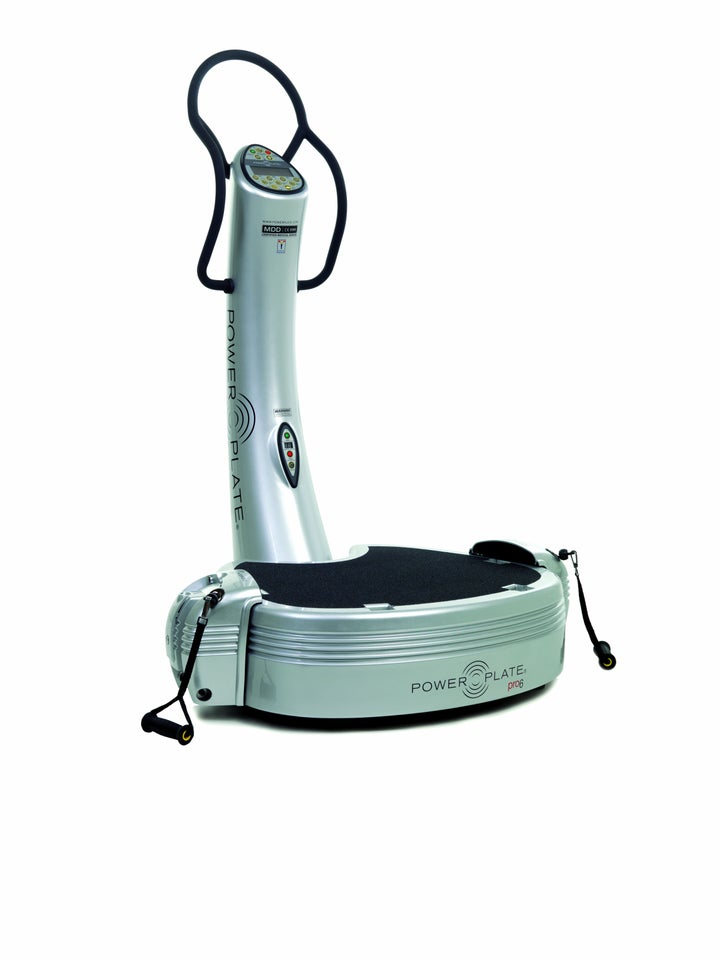
Can you shake yourself fit? It's not a new concept actually. The Russians used vibration training exercise on cosmonauts when their researchers found this technology could prevent loss of bone density and muscle tissue, two major problems caused by spending an extensive amount of time in zero gravity. In fact, the Russians were able to keep their cosmonauts spacebound nearly four times longer than the Americans. That was probably good news to our astronauts. I doubt that living in a capsule for some 400 plus days was pleasant, but I assume the Russian space program was pretty pleased with their accomplishment.
Today, this vibration technology is slowly but surely becoming a sought after trend in the fitness world. In case you haven't seen a whole body vibration (WBV) unit yet, it's basically just a platform no higher than a step bench. Some have a console and handles you can hold on to, and it also allows you to adjust the settings, much like any treadmill (but much smaller). The trend is still on the cutting edge of the gym world, since the costly machines, are well ... costly and the research on whole body vibration is still relatively limited and new compared to the more traditional methods of training. However, the studies published so far look pretty darn good.
Until recently, I've only used a vibration plate a couple of times. Once in a Power Plate class at a studio and once on an infomercial shoot for a major fitness equipment company back in 2007. Both times I recall feeling mildly sore next day. Cut to this year when a gym I train at (Sports Club/LA) purchased a couple of Vibe Plates. I was gung-ho to try them out again and see what benefits I might get. So I looked up the published research on WBV and found a lot of very positive results. For example, the Journal of Sports Science and Medicine published a study in 2007 from the Department of Sport and Exercise Science at the University of Athens showing significant improvements in sprint speed and strength in only six weeks of training. The volunteers (12 men and 12 women) were all young, active athletes. And a 2003 study in Medicine & Science in Sports & Exercise showed significantly increased strength of knee-extensors (the muscles in the front of your thigh) in 67 untrained female volunteers.
But improved strength of the quadriceps may not be the only benefit of getting your shake on. Other studies have shown increased bone density, postural control, and improved mobility and balance in older users. Plus, another study found WBV training improved balance and proprioception (the body's internal awareness of movement and special orientation) in athletes with reconstructed ACLs. Newer studies are also looking into how WBV might benefit body composition (the percentage of fat versus lean body tissue) -- basically asking if WBV can help you lose weight. There isn't much news on this yet, but a 2009 study has concluded that a combination of resistance training and whole-body vibration was effective for decreasing the percentage of body fat in post menopausal women. And more recently, preliminary data shows that WBV training may have the potential to reduce visceral adipose tissue (the fat around the organs) more than aerobic exercise in obese adults, possibly making it a meaningful addition to future weight loss programs. Other possible areas of use may be for spinal cord injuries, arterial stiffness and fibromyalgia. Again, all of this is pretty new, so more studies are definitely still needed.
How much vibration should there be? You can set the frequency to how many vibrations you want per second, meaning how many contractions the working muscles will make per second. The recommended amount (and the amount used in many of the studies) is 25 - 40 Hz. The amplitude is how much vertical movement the platform is making and is measured in millimeters. Higher numbers mean higher intensity on the muscles. Scientists believe vibration training recruits fast-twitch muscle fibers -- the ones that are responsible for explosive power, speed and strength -- and are also hard to train!
So, what do you do on one of these gizmos if you have access to one or enough spare cash to put one in your home gym? Several of these studies have the participants simply squatting -- either holding a partial squat for 30 seconds to a minute, or a dynamic squat with the thighs parallel to the floor. The part of the body closest to the vibrating platform will get the most benefit. Personally I like doing planks, push-ups, hip bridges, crunches, triceps dips, calf raises and stretching. Have I noticed a difference? Well, I've only been at it for a couple of weeks, but with research as promising as this, I hope to be running faster and jumping higher in my boot camps soon!